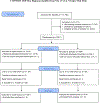Epidemiology of readmissions in early infancy following nonelective cesarean delivery
- PMID: 32669643
- PMCID: PMC7854783
- DOI: 10.1038/s41372-020-0730-1
Epidemiology of readmissions in early infancy following nonelective cesarean delivery
Abstract
Objective: Determine incidence and risk factors for readmissions in early infancy.
Study design: Secondary analysis of data from the Cesarean Section Optimal Antibiotic Prophylaxis trial. All unplanned revisits (unplanned clinic, ER visits, and hospital readmissions) and hospital readmissions (initial discharge to 3-month follow-up) were analyzed.
Results: 295 (15.9%) of 1850 infants had revisits with risk factors being ethnicity (adjusted odds ratio (aOR): 0.6 for Hispanic), maternal postpartum antibiotics (1.89), azithromycin treatment (1.22), small for gestational age (1.68), apnea (3.82), and hospital stay after birth >90th percentile (0.49). 71 (3.8%) of 1850 infants were readmitted with risk factors being antenatal steroids (aOR 2.49), elective repeat C/section (0.72), postpartum maternal antibiotics (2.22), O2 requirement after delivery room (2.82), and suspected/proven neonatal sepsis (0.55).
Conclusion(s): Multiple risk factors were identified, suggesting potential impact on the neonatal microbiome (maternal postpartum antibiotics) or issues related to access/cost of care (Hispanic ethnicity associated with fewer revisits).
Conflict of interest statement
Figures
References
-
- Lorch SA. National Quality Measures in Perinatal Medicine. Clin Perinatol 2017, 44(3): 485–509. - PubMed
-
- Jonas JA, Devon EP, Ronan JC, Ng SC, Owusu-McKenzie JY, Strausbaugh JT, et al. Determining preventability of pediatric readmissions using fault tree analysis. J Hosp Med 2016, 11(5): 329–335. - PubMed
-
- Hain PD, Gay JC, Berutti TW, Whitney GM, Wang W, Saville BR. Preventability of early readmissions at a children’s hospital. Pediatrics 2013, 131(1): e171–181. - PubMed
Publication types
MeSH terms
Substances
Grants and funding
LinkOut - more resources
Full Text Sources
Medical


